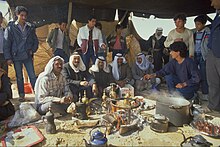
Back بدو النقب Arabic بدو النقب ARZ بادیهنشینان نگب Persian בדואים בישראל HE Bedouin Negev ID Negev-bedoeïenen Dutch Негевские бедуины Russian Necef Bedevileri Turkish
 Bedouin men at a party | |
| Total population | |
|---|---|
| Over 200,000 | |
| Regions with significant populations | |
| 200,000–210,000[1][2][3] | |
| Languages | |
| Native language: Arabic (mainly Bedouin dialect, also Egyptian, Secondary language : Hebrew (Modern Israeli) | |
| Religion | |
| Islam | |
| Related ethnic groups | |
| Other Bedouin | |
| Part of a series on |
| Islam |
|---|
 |
The Negev Bedouin (Arabic: بدو النقب, Badū an-Naqab; Hebrew: הבדואים בנגב, HaBedu'im BaNegev) are traditionally pastoral nomadic Arab tribes (Bedouin), who until the later part of the 19th century would wander between Hijaz in the east and the Sinai Peninsula in the west.[4] Today they live in the Negev region of Israel. The Bedouin tribes adhere to Islam and many are loyal Israeli citizens.[5][6][7][8] Some Bedouins voluntarily serve in the IDF.[9][10]
From 1858 during Ottoman rule, the Negev Bedouin underwent a process of sedentarization which accelerated after the founding of Israel.[11] In the 1948 Arab–Israeli War, most resettled in neighbouring countries. With time, some started returning to Israel and about 11,000 were recognized by Israel as its citizens by 1954.[12] Between 1968 and 1989, Israel built seven townships in the northeast Negev for this population, including Rahat, Hura, Tel as-Sabi, Ar'arat an-Naqab, Lakiya, Kuseife and Shaqib al-Salam.[13]
Others settled outside these townships in what is called the unrecognized villages. In 2003, in an attempt to settle the land disputes in the Negev, the Israeli government offered to retroactively recognize eleven villages (Abu Qrenat, Umm Batin, al-Sayyid, Bir Hadaj, Drijat, Mulada, Makhul, Qasr al-Sir, Kukhleh, Abu Talul and Tirabin al-Sana), but also increased enforcement against "illegal construction". Bedouin land owners refused to accept the offer and the land disputes still stood.[14] The majority of the unrecognized villages were therefore slated for bulldozing[15][16] under the Prawer Plan, which would have disposessed 30,000-40,000 Bedouins.[17] After large protests by Bedouins and severe criticism from human rights organizations, the Prawer plan was rescinded in December 2013.[17][18]
The Bedouin population in the Negev numbers 200,000–210,000. Just over half of them live in the seven government-built Bedouin-only towns; the remaining 90,000 live in 46 villages – 35 of which are still unrecognized and 11 of which were officially recognized in 2003.[2][15]
- ^ "Arrests at protest over Israel's Bedouin plan". Al Jazeera English. 1 December 2013. Retrieved 9 February 2014.
- ^ a b Noreen Sadik (23 July 2013). "Israel's Bedouin population faces mass eviction -- New Internationalist". Retrieved 29 May 2016.
- ^ "Behind the Headlines: The Bedouin in the Negev and the Begin Plan". Israeli Ministry of Foreign Affairs. 4 November 2013. Retrieved 9 February 2014.
- ^ Yahel, Havatzelet; Kark, Ruth (2 January 2015). "Israel Negev Bedouin during the 1948 War: Departure and Return". Israel Affairs. 21 (1): 48–97. doi:10.1080/13537121.2014.984421. ISSN 1353-7121. S2CID 143770058.
- ^ "Bedouin Life". Archived from the original on 7 March 2016. Retrieved 29 May 2016.
- ^ Goering, K. (1979). Israel and the Bedouin of the Negev. Journal of Palestine Studies, 9(1), 3-20.
- ^ Yonah, Y., Abu-Saad, I. and Kaplan, A., 2004. De-Arabization of the Bedouin: A study of an inevitable failure. Interchange, 35, pp.387-406.
- ^ Parizot, C., 2001. Gaza, Beersheba, Dhahriyya: another approach to the Negev Bedouins in the Israeli-Palestinian space. Bulletin du Centre de recherche français à Jérusalem, (9), pp.98-110.
- ^ Geller, R.S., 2017. Minorities in the Israeli military, 1948–58. Lexington Books.
- ^ Rozenman, E., 1999. Israeli Arabs and the future of the Jewish state. Middle East Quarterly.
- ^ Cite error: The named reference
Kurtwas invoked but never defined (see the help page). - ^ Porat, Khanina (2000). "The State of Israel's Measures and the Left's Alternatives for the Resolution of the Negev Bedouins Dispute 1953-1960" (PDF). עיונים בתקומת ישראל. 10: 420–479 – via Ben Gurion University.
- ^ "Ministry of Justice & Ministry of Foreign Affairs: List of Issues to be taken up in Connection with the Consideration of Israel's Fourth and Fifth Periodic Reports of Israel, November 2010" (PDF). Archived from the original (PDF) on 15 October 2013. Retrieved 12 August 2021.
- ^ "Bedouins in the State of Israel". Knesset homepage. Retrieved 12 August 2021.
- ^ a b "Israel's bedouin battle displacement". Al Jazeera. 29 August 2013. Retrieved 8 December 2013.
- ^ "Protesters clash with police over Bedouin displacement plan". CNN. 30 November 2013. Retrieved 8 December 2013.
- ^ a b "Bedouins in Israel Protest Plan to Regulate Settlement". The New York Times. 1 December 2013. Retrieved 29 May 2016.
- ^ Seidler, Shirly (2 December 2013). "Israeli Government Claims 80% of Bedouin Agree to Resettlement; Bedouin Leader: State Is Lying". Haaretz. Retrieved 29 May 2016.
© MMXXIII Rich X Search. We shall prevail. All rights reserved. Rich X Search